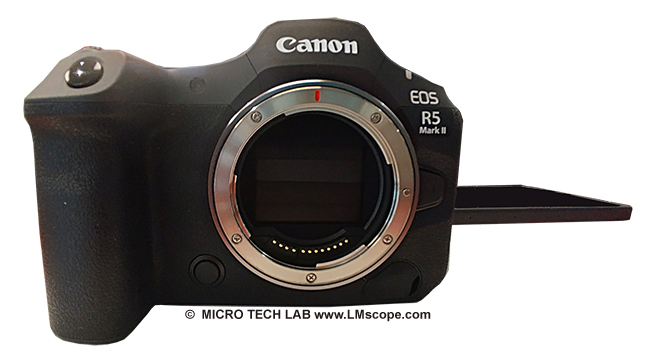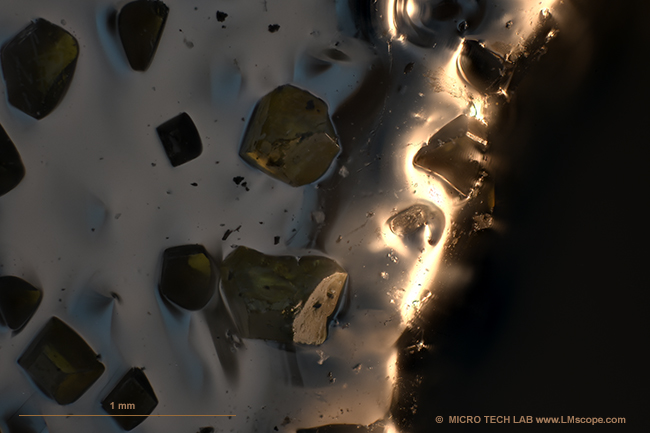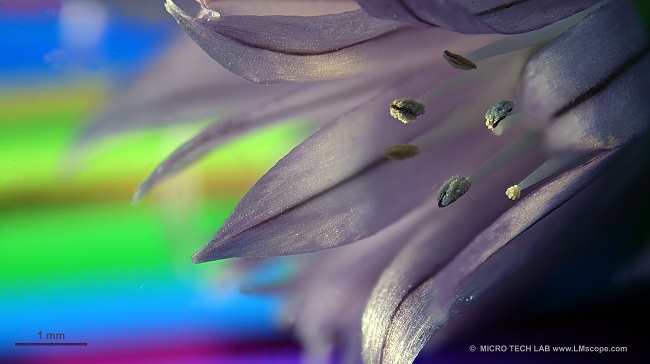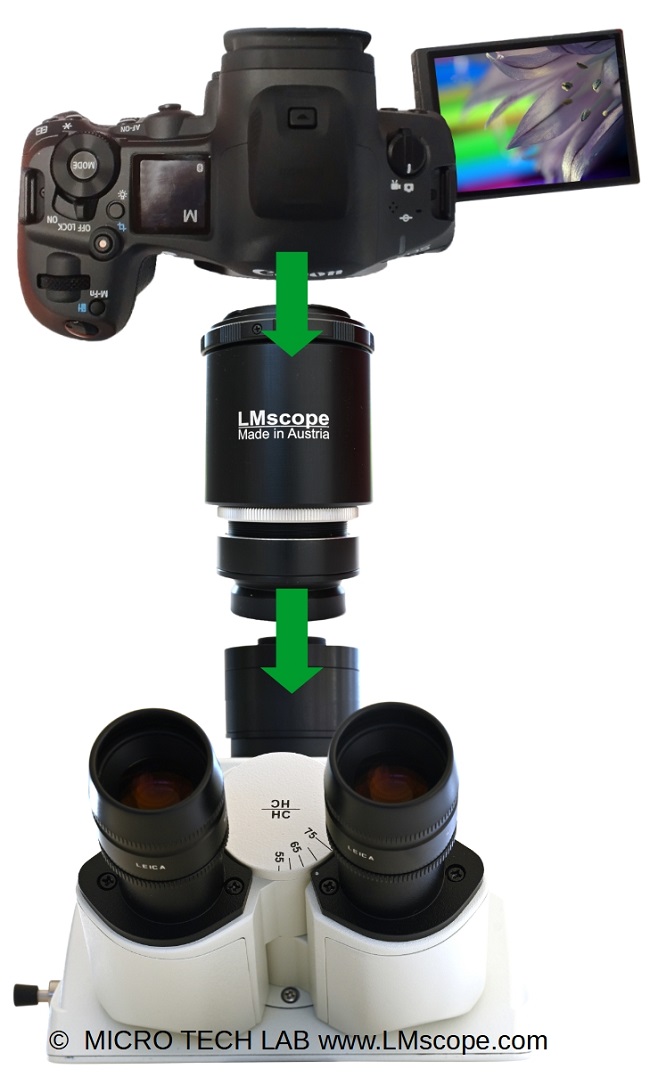

The Canon EOS R5 Mark II tested on the microscope: state-of-the-art technology, combined with professional microscope adapters, facilitates high photo and video quality
The Canon EOS R5 Mark II is a high-resolution mirrorless full-frame system camera that was released in summer 2024. Aimed at professional photographers and videographers, the R5 II is a powerful hybrid camera with particularly strong video capabilities – which is also advantageous for microscopy applications. Priced at around EUR 4,700 (as of 2025), the R5 II is a highly capable all-round camera with a powerful 45 megapixel full-frame sensor with backside illumination technology. The camera’s image sensor features a wide dynamic range and is also highly light sensitive, making it a great choice for microscopy applications both in photo and in video mode.
With our LM microscope adapters, featuring built-in precision optics, the EOS R5 II can be attached to a wide range of microscopes – either via the phototube or the eyepiece tube. Depending on the microscope, we can offer customised adapter solutions with an integrated optical system.
Thanks to state-of-the-art camera technology, the image quality achieved far surpasses that of conventional C-mount microscope cameras. The R5 II boasts incredible speed, featuring an electronic shutter capable of exposure times as fast as 1/32,000 of a second. This allows for the capture of fast processes or moving microorganisms in pinpoint detail!

Overview of the camera’s key features:
- 45 megapixel back-illuminated stacked CMOS full-frame sensor
- Up to 1/32,000 sec shutter speed with electronic shutter in photo mode
- Continuous shooting at up to 30 fps at maximum resolution with electronic shutter
- ISO range 100 to 51,200 (expandable to ISO 102,400)
- Full-sensor-width 8K RAW and 4K video recording
- 8K video with 60 fps, 4K video with 120 fps for slow motion recording, maximum 360 minutes
- USB 3.2 type C for data transfer, continuous power and charging
- Two memory card slots for SD cards (compatible with CFexpress Type B cards in slot 1 and with SD/SDHC/DSXC cards for Full HD resolution in slot 2)
- HDMI Type A interface, WiFi 6E
- Vari-angle touchscreen LCD monitor: 8.0 cm (3.2 inch) TFT colour LCD screen with 2.1 million pixels
- Lens mount: Canon R-mount

Shown in the image: drill bit with industrial-grade diamonds under the microscope. Image taken with the Canon EOS R5 Mark II, 3 mm field of view (FOV)
Featuring the same powerful 45 megapixel full-frame sensor as its predecessor, the R5 II excels in capturing overview shots at low magnification, because the high resolving power of the camera makes even more details visible. With a native ISO range of 100 to 51,200, expandable to 102,400, the sensor is very light sensitive. However, to achieve the best dynamic range, sticking to the lower end of the ISO spectrum (around ISO 100) is advisable, although the perfect balance will vary depending on the specific situation.

Shown in the image: chive blossom under the microscope. Image taken with the Canon EOS R5 Mark II, 9 mm field of view (FOV)
The ability to control the camera directly from a PC or Mac is a big advantage, particularly when working on a computer. The live image is output to a large, high-resolution external monitor, which enables precise focusing and easy adjustment of camera settings. Canon’s EOS Utility software is a great tool for controlling the camera remotely from the computer. The images are directly filed on the hard drive and are available for further processing there.
As an alternative to an external monitor, the large, flexible touchscreen with a diagonal size of 8 cm is a practical option. Its articulating design lets you work from a range of angles, which allows flexible viewing of the live image.

Canon’s EOS R5 Mark II uses artificial intelligence across multiple areas.
- One of them is the camera’s autofocus system. However, when attached to a microscope, this feature becomes irrelevant since focusing is manually controlled through the microscope’s micrometer adjustments.
- Another smart feature is the R5 II’s in-camera image upscaling, which uses deep learning algorithms to upscale standard 45 MP JPEG images to up to 180 MP.
- The camera uses the same technology for noise reduction, preserving fine detail while removing any noise at high ISO sensitivities.
The R5 II is a powerhouse when it comes to video capabilities, supporting internal 8K raw video recording at up to 60 fps. The only catch is the maximum video recording time of 360 minutes. With the integration of advanced video tools like Canon Log 2 (for enhanced dynamic range) and sophisticated exposure monitoring features, the R5 II blurs the line between stills cameras and professional cinema cameras.
In camera systems, effective heat management is crucial for minimising image noise. Compared to its predecessor model, Canon has reportedly enhanced this aspect in the R5 II with a body crafted from a magnesium alloy.
For extended use, Canon offers a versatile grip equipped with an active cooling system, which is ideal for prolonged 8K recording sessions or environments with high temperatures. This multifunctional grip also features a built-in Ethernet (LAN) port.
To enhance speed and streamline workflows, the R5 II features a dual processor setup with Canon’s DIGIC X processor and the new DIGIC Accelerator co-processor. This combination ensures faster data processing speeds. The R5 II also has a pre-capture feature. With this setting activated, the camera will record up to 15 frames or up to 5 seconds of video before actually pressing the shutter.
Conclusion: The Canon EOS R5 Mark II is a very powerful camera and also a great choice for use with a microscope. Compared to its predecessor, the EOS R5 Mark I, the R5 II has been optimised for speed, especially when it comes to video and continuous shooting performance, thanks to significant improvements in sensor technology, processing power and smart features. However, there hasn’t been an improvement in dynamic range for still photography. According to Canon, the camera’s built-in AI features (deep learning, …) can be leveraged for advanced noise reduction and image optimisation. With our LM adapter solutions, designed with integrated wide-field optics, the R5 II can be attached to almost any microscope. This setup allows you to capture photos and videos of exceptional quality, offering a superior option to conventional microscope C-mount cameras.
28.05.2025New LM Digital Adapter for: Sony Alpha 9 III / Nikon Z9 / Nikon Z8 / Sony Alpha 7R V / Sony Alpha 1 II / Sony Alpha 1 / Sony Alpha 9 II (ILCE-9M2) / Sony FX3 Cinema Line / Sony Alpha 9 / Nikon D6 / Canon EOS R3 / Canon EOS R6 Mark II / Canon EOS R8 / Sony Alpha 7R IV / Canon EOS R5 II / Nikon Z6III / Canon EOS R5 / Sony Alpha 7S II / Sony Alpha 7S III / Sony Alpha 7R III / Canon EOS R6 / Nikon Z6 / Nikon Z6II / Sony Alpha 7R II / Nikon Z7 / Nikon Z7II / Canon EOS R / Canon EOS Ra (Astro) / Nikon Z5 / Sony Alpha 7C / Canon EOS RP / Sony Alpha 7S / Canon EOS R7 / Leica SL2-S / Canon EOS R10 / Nikon Z50 II / Canon EOS 1D X Mark III / Nikon Z50 / Nikon Z30 / Nikon Z fc / Nikon D850 / Canon EOS 1D X Mark II / Nikon D780 / Olympus OM-1 / Sony Alpha 7III / Olympus OM-D E-M1 Mark III / Canon EOS R100 / Sony Alpha 6700 / Nikon D5 / Sony Alpha 6600 / Fujifilm X-H2S /